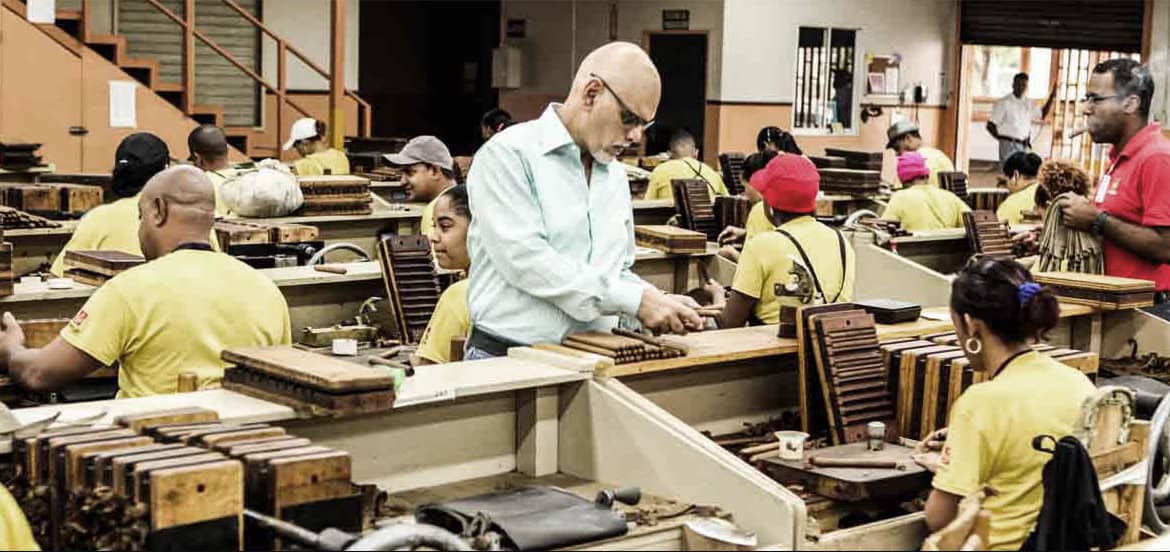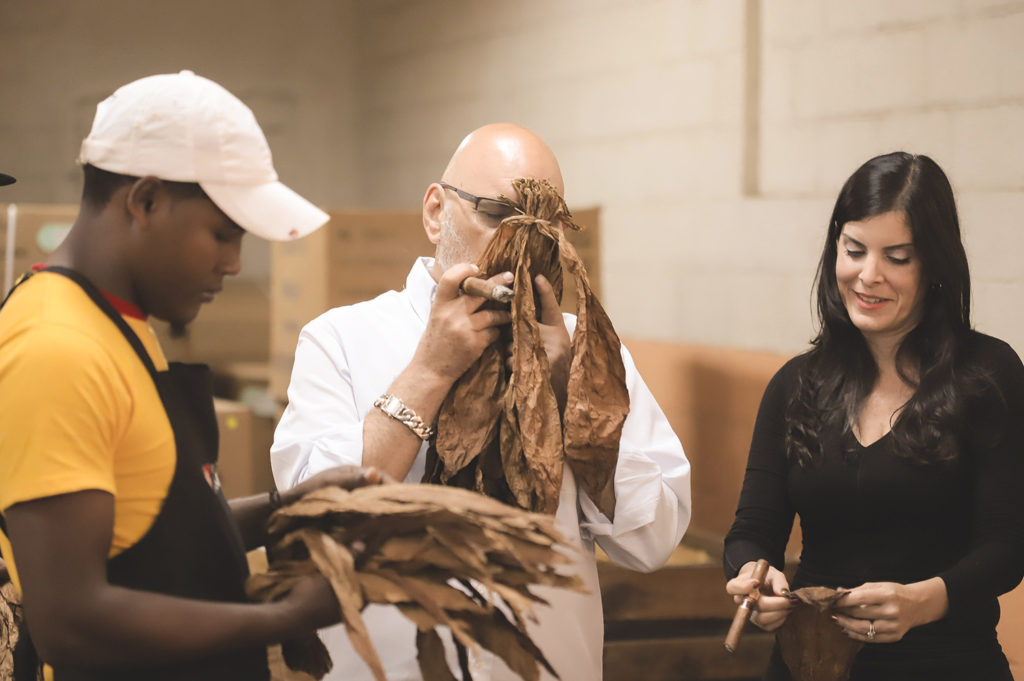As master cigar blenders, we have carefully cultivated the fine process of how to make a cigar. The basic composition of a cigar is a tobacco leaf wrapped around other tobacco leaves, known as the binder and filler. Many consider cigar smoking the best way to truly enjoy tobacco because the experience is boiled down to the plant itself and moisture. Understanding how to make a cigar can enhance how one is enjoyed.
History of Cigars
When Columbus landed in Cuba, he probably found the native people rolling cigars. After discovering the art of cigar smoking, he likely sent them back to Spain, Portugal, and the rest of Europe. Those in the know would discover the joys of cigar smoking and the rudimentary versions of what evolved into today’s cigar.
As early as the late eighteenth century, cigar factories emerged in Spain and other parts of Europe. For many, cigar smoking was strictly for the affluent and elite members of society. Women smoking cigars was prohibited and it was limited to the men of the aristocracy only. At the time, women considered cigar smoking vulgar due to its origins in the smoking club of England (a prototype cigar lounge).
Eventually, cigars went out of style, but the culture and society were there to stay. Machine-made cigars emerged in the early 20th century, but our focus is on handmade cigars. Famous names like Winston Churchill, Groucho Marx, John F. Kennedy, Calvin Coolidge, Al Capone, and Arnold Schwarzenegger helped put cigars on the map. They have helped keep the joy of smoking alive and well.
What Are Cigars Made of?
Understanding what cigars are made of can make the experience much more enticing. All the high-quality, premium, best cigars are handmade with raw materials. The star ingredient will always be tobacco.
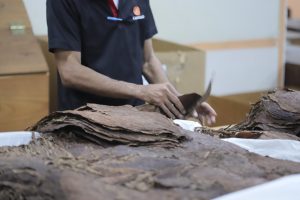 The filler is what is inside of the cigar. These leaves may have blemishes or imperfections but are still a key component in allowing the cigar to burn. Typically, filler leaves do not need to be aesthetically pleasing. Their main role is burning and developing the cigar’s flavor profile.
The filler is what is inside of the cigar. These leaves may have blemishes or imperfections but are still a key component in allowing the cigar to burn. Typically, filler leaves do not need to be aesthetically pleasing. Their main role is burning and developing the cigar’s flavor profile.
The binder leaf is what holds the filler leaves together. It is usually a single leaf that holds the filler together in a uniform way, free from the need to satisfy visually. It is a vital player in the cigar’s construction and flavor.
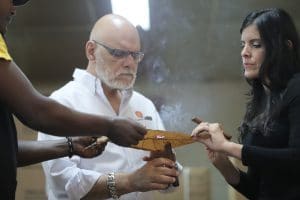 The wrapper is a finely textured leaf that is used to wrap and finish the cigar. The type of cigar wrapper impacts the appearance, which is very important. Since the wrapper leaf touches your mouth directly, it can be the most essential ingredient in the cigar-making process. The different types of cigar wrappers can sway the entire cigar experience.
The wrapper is a finely textured leaf that is used to wrap and finish the cigar. The type of cigar wrapper impacts the appearance, which is very important. Since the wrapper leaf touches your mouth directly, it can be the most essential ingredient in the cigar-making process. The different types of cigar wrappers can sway the entire cigar experience.
Lastly, a cigar must be held firmly together with a nondescript, organic, and tasteless gum. It is mainly used at the head of the cigar (the top, round side) and rarely used anywhere else. A printed band, usually made of paper, is wrapped around the cigar to help smokers recognize their favorite brands, like the Perez-Carrillo Series.
Before the Cigar Rolling Table
Cigars start as simple as thousands of seeds in the palm of your hand. The seeds are sorted, planted into their own pods, watered, and watched for 6 to 10 weeks. They must stay out of direct sunlight. After several months, they should’ve grown 6 to 8 inches and are moved to a new area to continue growing.
Once the tobacco plant is ready, the leaves are picked and cured which is where the aroma develops. Otherwise known as air-curing, this ventilation process requires the leaves to be hung on strips of wood. During this process, the leaves change from green and flexible to yellow and dry. The natural chlorophyll is broken down and replaced with carotene.

Another option is flue-curing, which is like air-curing but works with smaller quantities and heat to speed up the process. These are more popularly known as small batch cigars. Heating the leaves can leave them overdried and encroaches on nature’s wisdom.
After being cured, the leaves are sorted by color and size, then used or sold. Not every manufacturer has its own farm or factory. Some farmers sell crops to cigar makers and some crops have fermentation involved.
Leaves are tied into bundles of 10 to 15 leaves during the fermentation process. It can take 6 months to 5 years to achieve desired outcomes. The purpose of fermentation is to develop the aroma and flavor of the leaves. Once this process is over, the leaves are sorted by hand again.

Next, the leaves enter the stripping area where the long vein (or stem) that runs down the middle of the leaf is removed. This can be done by hand or machine. Next, the leaves are stacked into books so they can be stored for final production.
Rolling A Cigar
Rollers can be used for individual cigars or pairs. Each manufacturer is different, but most of them use the pairing process. First, they choose the number of filler leaves needed for a particular cigar blend. Filler leaves come in different sizes, shapes, colors, and even can be from different countries.
From here, they are bunched together by hand so the roller can feel the balance and weight of the leaves. You don’t want to put anything in the filler that affects the draw. Once this is done, the roller wraps the binder leaf around the filler in a cylindrical motion, either by hand or machine.
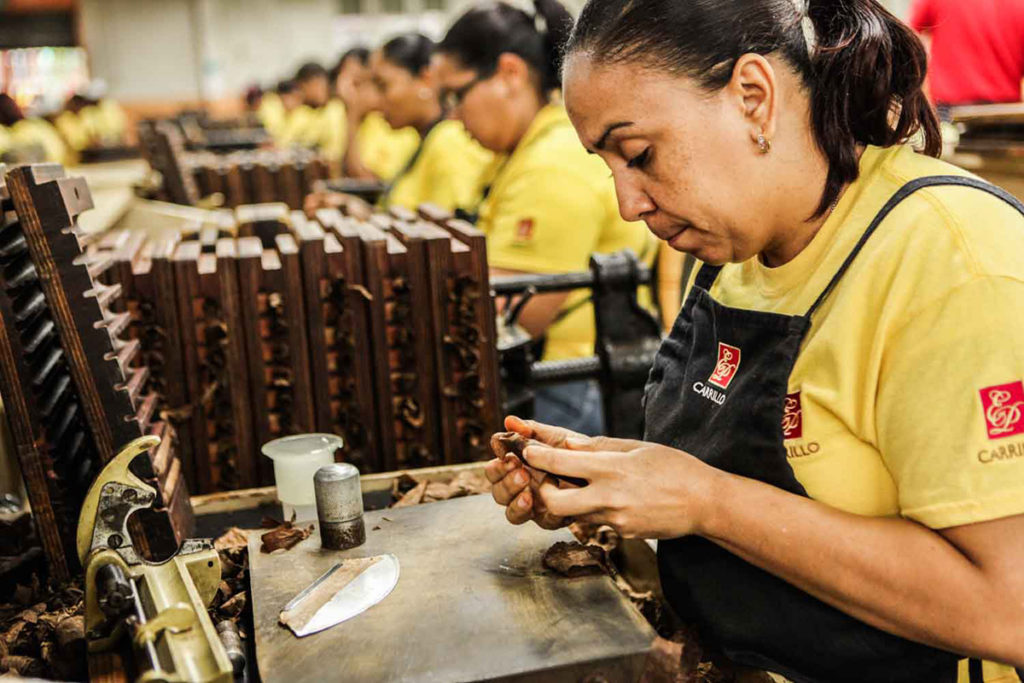
The binder is the finishing touch in a cigar’s recipe. The wrapper is then used to keep the cigar uniform. Wrapping the cigar is probably the hardest part, requiring firm yet delicate patience so it does not break. Strong eyesight is needed to ensure the wrapping is done to visual perfection.
A chaveta is then used to cut the cigar. The ends of the cigar are cut so a cap can be added. This is the circular piece of tobacco that prepares the cigar for being packed. Some of the finest cigars have a triple-cap, swallowing the whole wrapper leaf and appearing like three seams.
At this point, the cigar goes into a special room to age. The Aging Room lets the cigar rest and allows oils to marinate. In some cases, cigars will visit a drying room too to make sure it is at the proper level of humidity.
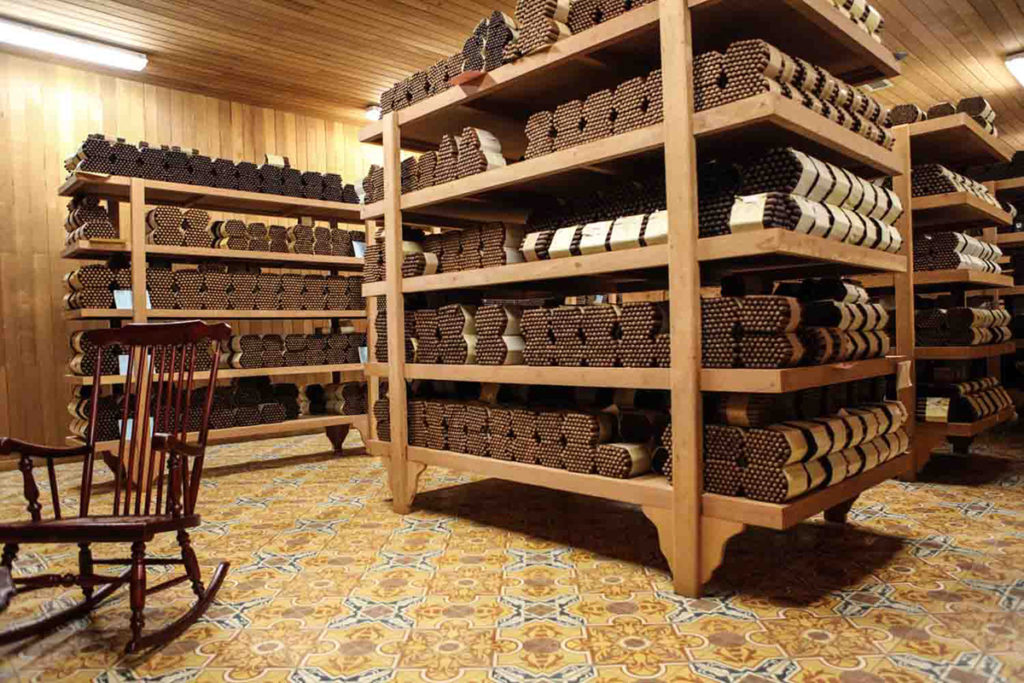
Next, the quality of the cigar is verified. If it passes, a band is applied by hand, and it is moved into a box. Some utilize some form of inner packaging for extra safety. These are now ready for consumers to smoke.
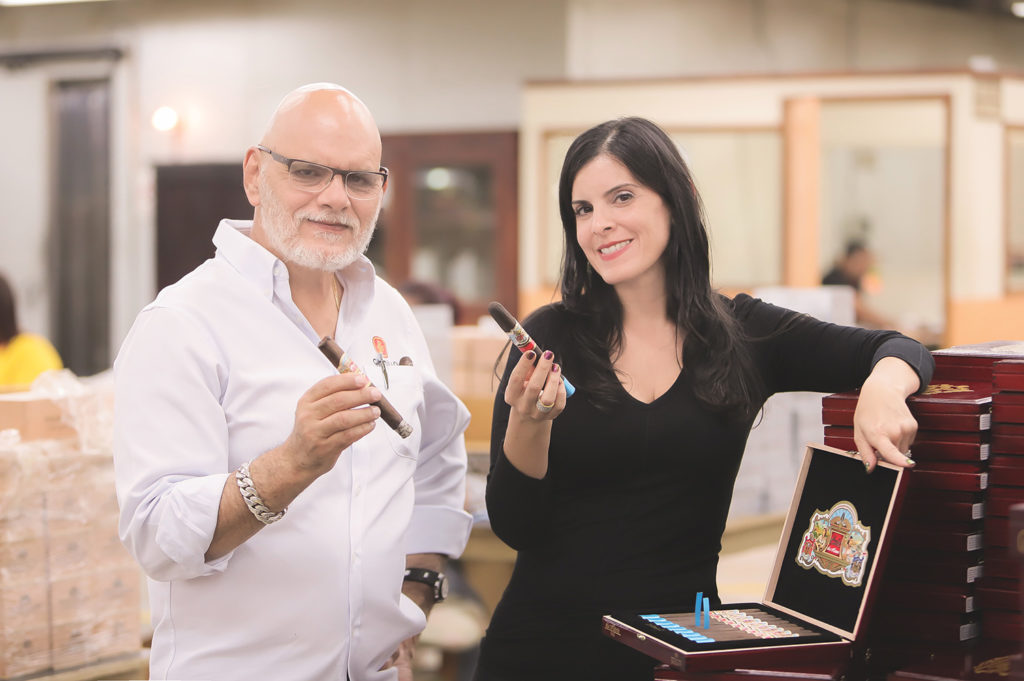
Quality Control
All the best cigar factories use some method of quality control. Every step in the process has a checkpoint that needs to be passed. The way the cigar looks, tastes, smells and is packaged are all looked at closely. There are so many checkpoints because making a cigar is almost all done by a skilled, human hand.
The passionate cigar blenders aim to create the best cigars on the market. Every person the cigar passes through cares about creating a quality product that can be enjoyed with friends and family, over good food and conversation. Remember this the next time you cut, light, and smoke a cigar.
Hand-Rolled Vs. Machine-Made Cigars
For many smokers, the difference between premium hand-rolled cigars and machine-rolled cigars is something of a mystery.
Does how a cigar is rolled really make a difference in how it smokes? Are hand-rolled cigars inherently better or are they just more expensive?
Here’s what you need to know about the differences between these two categories of cigars and why handmade cigars are superior to machine-rolled sticks.
The Main Difference in These Cigar Types
The key difference between these two types of cigars is that one is hand-rolled by an experienced cigar maker and the other is created by a rolling machine. This distinction results in important differences smokers should be aware of.
 Handmade cigars use long-filler leaves that contribute to flavor, strength, and the quality of the burn. By contrast, machine-rolled cigars are made with lower-quality chopped tobacco in the filler. In this regard, machine-rolled cigars resemble cigarettes more than traditional hand-rolled cigars.
Handmade cigars use long-filler leaves that contribute to flavor, strength, and the quality of the burn. By contrast, machine-rolled cigars are made with lower-quality chopped tobacco in the filler. In this regard, machine-rolled cigars resemble cigarettes more than traditional hand-rolled cigars.
The binders and wrappers of machine-rolled cigars are also fundamentally different from those used in a handmade cigar. To make machine rolling possible, the binder leaves used in traditional cigars are replaced with a combination of ground tobacco and adhesive. Machine-rolled cigar wrapper types are usually not made entirely from natural tobacco leaves, robbing these cigars of the flavor and texture you’d find in a premium smoke.
Finally, machine-rolled cigars often include chemical additives and preservatives that you would never find in a handmade cigar. As any cigar aficionado will tell you, a great cigar is all about the natural flavor of premium tobacco leaves. With the addition of synthetic chemicals, machine-rolled cigars lose a great deal of their natural flavor.
Put together, these factors create a considerable difference between machine-rolled and hand-rolled cigars. In terms of flavor and quality, handmade cigars are almost universally superior to their machine-rolled cousins.
Spotting A Machine-Rolled Cigar
There are several ways to spot the difference between a machine-rolled cigar and a premium hand-rolled cigar. The first and most obvious difference between the two is price. Machine-rolled cigars are typically inexpensive and can be found at discount smoking shops and even gas stations. By contrast, hand-rolled premium cigars cost a bit more and are seldom sold at a facility without a proper cabinet or walk-in humidor.
Looking at a cigar will also give you some tell-tale signs as to how it was made. The wrapper on a hand-rolled cigar should be tightly stretched and firm, while machine-rolled sticks are often less precise. The pure, natural tobacco leaf used to wrap a hand-rolled cigar should be soft to the touch and slightly reflective under direct light, from the leaf’s natural oils. Oils aren’t concentrated in machine-rolled cigar wrappers, so they appear dull and feel dry.
If price and appearance aren’t enough, you’ll likely spot a machine-rolled cigar when you light it up. Between chemical impurities and less oily wrappers, machine-rolled cigars burn more quickly and get hotter than handmade cigars. This leads to a harsher, less flavorful smoke.
Overall, a premium hand-rolled cigar is a better tobacco product than a machine-rolled stick. With that said, machine-rolled cigars have the advantage in terms of price. This can make them an affordable option if you’re a daily smoker or just want cheaper selections to put in your humidor. When you’re looking for a better cigar, handmade is always the way to go.


